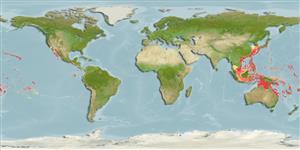Environment: milieu / climate zone / depth range / distribution range
Ökologie
seewasser riff-verbunden; tiefenbereich 6 - 130 m (Ref. 89972). Subtropical; 35°N - 31°S
Pacific Ocean: antitropical, from southern Japan, Hawaiian Islands, Clipperton Island, Revillagigedo Islands, southern California, Easter Island, and Pitcairn Islands.
Size / Gewicht / Alter
Maturity: Lm ? range ? - ? cm
Max length : 30.0 cm NG Männchen/unbestimmt; (Ref. 89467)
Rückenflossenstacheln (insgesamt): 3; Rückenflossenweichstrahlen (insgesamt): 29-32; Afterflossenstacheln 0; Afterflossenweichstrahlen: 26 - 29. Males are straw-yellow with each scale outlined in black creating a crosshatched appearance, and a red tail with neon submarginal blue band. Females are also crosshatched, but with a slate gray to blue ground color and tail.
Found mainly around oceanic islands and near reefs along the continental coasts (Ref. 9276). Found in schools in seaward reefs above drop-offs (Ref. 9710). Benthopelagic (Ref. 58302). Feeds on zooplanktons (Ref. 89972).
Males establish a territory for spawning and parental care but not for feeding (Ref. 116451). Only females tend the eggs but both parents keep guard (Ref. 116451).
Myers, R.F., 1991. Micronesian reef fishes. Second Ed. Coral Graphics, Barrigada, Guam. 298 p. (Ref. 1602)
IUCN Rote Liste Status (Ref. 130435)
Bedrohung für Menschen
Harmless
Nutzung durch Menschen
Aquarium: Kommerziell
Mehr Information
ReferenzenAquakulturAquakultur ProfilZuchtlinienGenetikElectrophoresesVererbbarkeitKrankheitenVerarbeitungNutrientsMass conversion
PartnerBilderStamps, Coins Misc.LauteCiguateraGeschwindigkeitSchwimmstilKiemenoberflächeOtolithsGehirngrößeSehfähigkeit
Tools
Zusatzinformationen
Download XML
Internet Quellen
Estimates based on models
Preferred temperature (Ref.
123201): 21.1 - 29, mean 27.8 °C (based on 1418 cells).
Phylogenetic diversity index (Ref.
82804): PD
50 = 0.5078 [Uniqueness, from 0.5 = low to 2.0 = high].
Bayesian length-weight: a=0.02570 (0.01232 - 0.05364), b=2.94 (2.77 - 3.11), in cm total length, based on LWR estimates for this (Sub)family-body shape (Ref.
93245).
Trophic level (Ref.
69278): 4.0 ±0.28 se; based on food items.
Widerstandsfähigkeit (Ref.
120179): hoch, Verdopplung der Population dauert weniger als 15 Monate. (Fec=32,000 (from an egg cluster)).
Fishing Vulnerability (Ref.
59153): Low vulnerability (18 of 100).
Nutrients (Ref.
124155): Calcium = 26.6 [10.3, 81.9] mg/100g; Iron = 0.662 [0.319, 1.736] mg/100g; Protein = 19.1 [16.9, 21.3] %; Omega3 = 0.208 [0.106, 0.407] g/100g; Selenium = 18.3 [7.9, 41.7] μg/100g; VitaminA = 56.9 [14.5, 228.7] μg/100g; Zinc = 0.584 [0.360, 0.928] mg/100g (wet weight);
